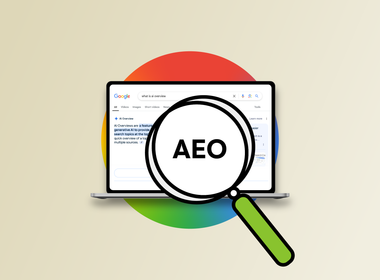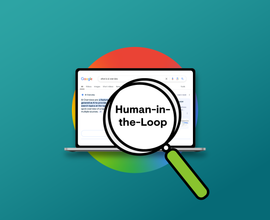What is Answer Engine Optimization? AEO Explained
What is answer engine optimization (AEO)?
Answer engine optimization (AEO) is the process of creating and formatting your content so that AI answer engines can easily understand and readily surface it to answer user questions. Unlike traditional search engines that offer a list of links, answer engines aim to deliver the specific answer a user needs, often in the form of a snippet, a knowledge panel, or even sometimes a voice response.
The core of AEO involves structuring information for clarity, ensuring factual accuracy, and directly addressing potential questions your audience might have. This means thinking about how users phrase their queries and optimizing content to match that natural language. It involves using clear headings, concise language, structured dataStructured Data
Structured data is the term used to describe schema markup on websites. With the help of this code, search engines can understand the content of URLs more easily, resulting in enhanced results in the search engine results page known as rich results. Typical examples of this are ratings, events and much more. The Conductor glossary below contains everything you need to know about structured data.
Learn more (like FAQs and how-to schemas), and ensuring your expertise on a topic is evident. The goal is to make it effortless for an answer engine to extract and present your information as the definitive answer.
AEO recognizes that user behavior is shifting towards expecting immediate information; users want answers, not just links. By optimizing for answer engines, you are positioning your content to be visible and valuable at critical customer interaction points, ensuring your brand's voice is heard even when users don't click on your webpage.
In traditional search, you're thinking of backlinks, you're thinking of content length, but with AEO, it's really all about creating very specific content and creating it at scale. In a traditional search engine, you're really getting the experience [of looking for an answer]. In the new era, LLMs just want to give you the answer.
AEO vs. GEO vs. SEO: What's the difference?
Understanding the nuances between AEO, generative engine optimization (GEO)Generative Engine Optimization (GEO)
The process of optimizing content for AI-powered search.
Learn more, and traditional search engineSearch Engine
A search engine is a website through which users can search internet content.
Learn more optimization (SEO) is key to navigating the evolving digital landscape. While all three aim to enhance online visibility, they target different mechanisms and have distinct focuses.
SEO: The primary goal of SEO is to drive traffic to your website through discoverability in search listings. This involves keywordKeyword
A keyword is what users write into a search engine when they want to find something specific.
Learn more research, link building, technical site health, and on-page optimization.
GEO, as outlined in our GEO article , focuses on making your content understandable and favorable for generative AI models. The aim here is to have your information influence or be directly used and cited when an AI creates new content or synthesizes an answer, often in conversational AI or more complex response generation scenarios.
AEO specifically targets platforms designed to provide direct answers (like Google's AI Overviews, Featured SnippetsFeatured Snippets
Featured snippets are highlighted excerpts of text that appear at the top of a Google search results page in what is known as ‘Position 0’.
Learn more, People Also Ask boxes, or voice search responses). While there's overlap with GEO, AEO is more narrowly focused on existing answer-providing features within traditional search and other AI search engines. It’s about structuring content to be the most direct, extractable answer to a specific question. While GEO might influence how an AI thinks and creates, AEO ensures your existing content is primed to be the answer in AI search.
AEO is more similar to SEO, in the sense that it's really a set of practices and techniques to understand and maximize how a brand shows up in these answer engines, like ChatGPT, Perplexity, and even Google's own AI mode.
Why is AEO important?
Answer engine optimization is crucial because it aligns your content strategy with the users’ expectations for immediate and direct information. As people increasingly turn to voice assistants, smart devices, and AI-powered search features that deliver answers upfront, ensuring your visibility within these answer formats becomes critical. If your content isn't optimized for AEO, you risk being invisible in these rapidly expanding channels, even if your traditional SEO is strong.
AEO ensures your brand or organization is the source of truth when users ask direct questions. This not only enhances your visibility but also builds authority and trust. When an answer engine consistently surfaces your content as the best response, it positions you as a knowledgeable leader in your field. This is particularly vital for capturing users who are looking for quick solutions or factual information without the intent to browse multiple websites.
The core benefits of AEO include:
- Increased visibility in "zero-click" search experiences
- Enhanced brand authority and trust
- Improved voice search performance
- A smoother user experience
- Future-proofing content
- And more
Examples of AEO strategies
Let's take a quick high-level look at how you can implement some AEO strategies to ensure your brand is visible across search experiences.
To effectively implement AEO strategies, you have to start by understanding the specific questions your audience is asking and designing your content to deliver clear, concise answers. What does this look like in practice?
- Use structured data, such as schema markup, to help AI-powered answer engines understand the context and relevance of your content.
- Focus on creating well-organized sections with descriptive headings, and prioritize formats like FAQs or step-by-step guides that naturally provide direct answers to user queries.
- Incorporate authoritative sources and up-to-date statistics to boost credibility, and ensure your language mirrors the conversational, natural queries users type or speak into modern search engines.
- Concentrate on providing value in as few words as possible. Clear and succinct answers increase your chances of being featured in “zero-click” results or voice search responses.
- Monitor your content’s performance in answer engines and use analytics to identify which answers perform best.
AEO in review
AEO represents a critical shift in how brands and marketers approach digital visibility. As answer engines continue to reshape the search landscape, simply ranking in standard search results isn't enough to reach your audience anymore. Adopting AEO ensures your content is structured, factual, and immediately actionable for both users and the AI systems surfacing information, helping you secure key positions in "zero-click" search spaces.
FAQs
- What is an answer engine?
- What is generative engine optimization (GEO)?
- What is AI optimization (AIO)?
- What is AI Mode?

![Patrick Reinhart, VP, Services and Thought Leadership, [object Object]](https://cdn.sanity.io/images/tkl0o0xu/production/9bc72298b24ad01b732de4c3376f79546d20f81c-3542x3542.png?fit=min&w=100&h=100&dpr=1&q=95)
![Wei Zheng, Chief Product Officer, [object Object]](https://cdn.sanity.io/images/tkl0o0xu/production/dcfa62c0fe34ba0c31f910b818874cd160ad8839-3542x3542.png?fit=min&w=100&h=100&dpr=1&q=95)






